Day Eight
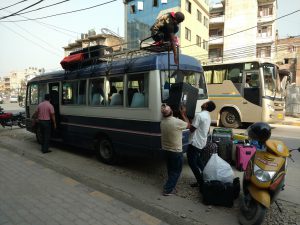
by Dr. Melinda Wilkins
I was so impressed with the students yesterday. Saturday was their day off, and most of them decided to pursue excellent learning opportunities on their own. One group headed to a milk processing plant, another to a dog shelter, and another group revisited the Infectious Disease Hospital and observed the ER for several hours. Dog bite and snake bite patients were observed, and the HIV ward was visited from a distance.
Today, we left the dusty, busy chaos of Kathmandu and transferred to our larger bus for the long drive to the Agriculture and Forestry University (AFU) in Rampur. The normally 6–7 hour drive ended up being closer to 12 hours, but the view was lovely, and it was amazing to watch the ecosystem change right before our eyes. We were hoping for a glimpse (through a telescope) of Mt. Everest, but it was too hazy. Our driver Bahji handled the constant switchbacks like a pro as we drove up out of the Kathmandu Valley and then headed down to the hot and steamy plains of the Terai region. Terai is the major agricultural region of Nepal, and the rice fields were impressive. Our gracious host, AFU, had the dormitory ready for us. There were a few more bugs, toads, and lizards than we expected, but everyone settled in quickly, and we were oh-so-grateful for the new overhead fans! Thank you, AFU!
Day Nine
by Rya Woodhams
Today was our first day at the Agriculture and Forestry University (AFU) located in Rampur, Nepal. Breakfast was a green potato curry soup with plain yogurt, fried bread, and hot tea. We started our day with a tour of the campus livestock research farms where we saw their facilities for cows, water buffalo, goats, chicken, pigs, and sheep. We also saw their aquaculture facilities, where they are producing carp and tilapia. It was very interesting to hear that AFU is involved in extension programs like MSU! They help farmers use better systems for their fish hatcheries. They have PhD students involved in researching the effects of algae on the fish ponds as well. The environment is much hotter in Rampur than it is in Michigan, so the livestock management practices are a little different. They let all of the ruminants out on pasture for the day and bring them in to their barns for the night.
Following our tours, we had a presentation from the faculty dean, Dr. Sharada Thapaliya, who told us that AFU only accept 50 students into their veterinary school per year. The education system in Nepal is different than in the US. For example, veterinarians do not go through undergraduate schooling or graduate with a DVM. They complete a bachelor’s of veterinary science and animal husbandry, which takes five-and-a-half years. We ended our educational material for the day with a presentation from Professor Naba Devkota, who is a nutrition specialist. He explained to us that Nepal has a feed and fodder shortage. Some of the difficulties in food production are the mountain terrain and maintaining enough forage during the winter season when food does not grow. Most people involved in agriculture also use their land for livestock.
It is very warm in Rampur. Today, the highest temperature was 108 degrees Fahrenheit. Now, we are finishing up the day relaxing in the air conditioning and working on our presentations.
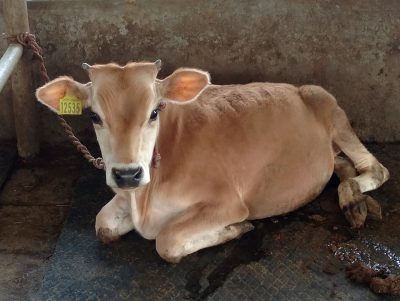
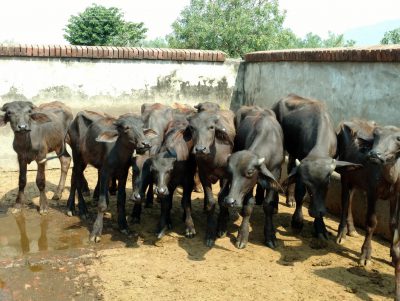
Day Ten
by Ruby Goss
Man, it’s hot here! Today, we started our morning with a trip to the district livestock office. It was pretty similar to the one in Kathmandu, but different because of the region of Nepal that we are in now. We were able to watch one of the veterinarians administer an antibiotic to one of the cows who they were trying to artificially inseminate. To do so, the medication was delivered through the cervix. It was quite the scene. On the same property was the avian influenza lab, where they test for disease and have a lot of reporting and surveillance going on. We were given a presentation on the facility and a tour. This afternoon, we were given a lecture about the emerging trends in aquaculture and fisheries in Nepal. This was incredibly interesting because we have mainly been focusing on livestock animals and human beings. It was a nice change of pace and pretty cool to learn how these practices are done in Nepal.
It was interesting to learn that aquaculture is a recently growing trend here, as the people have realized that it is an extremely important food sector. Meat can be expensive compared to alternative diet options. Therefore, people aren't getting enough of the essential proteins, fats, and amino acids that meat has to offer. Fish tends to be cheaper and has a high level of protein, which is really important for nutrition. It also was interesting to learn that they import 65 to 70 percent of the fish in the country from surrounding countries like India and China. There are 232 total species reported in Nepal and 217 of them are indigenous.

I am thoroughly surprised at how much knowledge I have obtained in the last 10 days. I seriously have learned so much more than I thought I would. I guess that's kind of the point of study abroad, learning on the fly. It’s nice to feel rewarded by learning lots of new things, knowing that I am looking at things differently because of what I’ve learned and that I will be able to apply this knowledge in the future.
Our second lecture was about the yak and chauri (a cross between yak and local cattle) husbandry. The lecture was given to us by the veterinary hospital director here at the university, and he focused on the seasonal transhumant system in the Hindu Kush Himalayan region. The yak is the iconic symbol of the Himalayan Mountains in Nepal. They are extremely important for the livelihoods of the people who live in these high-altitude regions. They are used for milk, meat, hide, and caravanning. The yak is the only major livestock that can take full advantage of the limited and inaccessible grasslands resources.
China is home to about 90 percent of the world’s yaks, but they range from Mongolia to the Tibet plateau and up to some parts of Russia. They really only exist in one region of the world. Because of this, there are some difficulties with their husbandry including breed degradation, inbreeding, and, most importantly, climate change. They are absolutely huge and full of fluff. These are the beautiful beasts of the mountains!
Day Eleven
by Meera Bhattarai
Today was an amazing day filled with fun and learning. After a traditional Nepalese breakfast, we headed out to our first stop—the Chitwan Medical College and Teaching Hospital, a private hospital in the area. Upon arriving, I was shocked. It was an enormous building with people on every corner. A Himalayan coffee shop welcomed everyone into the hospital.
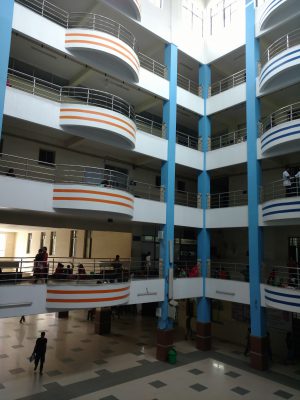
We then went up to the fourth floor, where we met with our first guest speaker, Dr. Muni Raj Chettri. He talked to us about popular zoonotic diseases seen in Chitwan, the most common one being rabies. About 15–20 people go to the hospital every day to get post-exposure prophylaxis after being bitten by an animal. After talking about other common zoonotic diseases, we took a tour of the hospital where we saw the many medical and dental wards.
The hallways were filled with medical students and families of the patients in the hospital. While we were in the hospital, the power went out twice. It was shocking considering surgeries were taking place at that very moment. This visit was very eye-opening, and it was interesting to see how things were dealt with here versus back in the Unites States. Around noon, we left the college to get lunch at a local restaurant. We all had momos, the unofficial national dish of Nepal, which were very delicious!
Our next stop was the regional hospital, which is a government-run hospital. Dr. Rudra Marasini talked to us about the history of the facility. He also took a small group of us on a tour of the hospital. We were able to see the emergency ward, as well as the male and female wards. The hospital was different from any I had seen before, including the one that morning.
After touring the regional hospital, we got on our bus and headed back to the Agriculture and Forestry University to meet with the vice chancellor, who talked to us about the history of the university. He explained how competitive the university is. Every year, about 4,000 people apply and only 200 are accepted. We’re all grateful that they let us stay in this amazing university! The discussion concluded our formal activities for the day. We relaxed for a couple of hours and then had a traditional dinner. Overall, it was a great day and I can’t wait for more!
Day Twelve
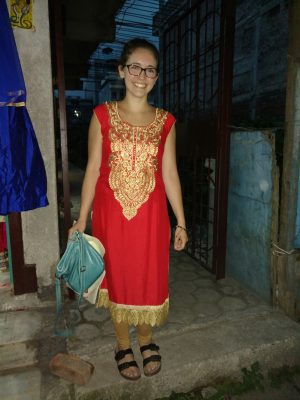
by Victoria Provenzola
Today, we had a more laid back and relaxing day, which was welcomed by us all since we have had quite a busy schedule these past two weeks. We started our morning off with two lectures after breakfast. The first was from I.P. Dhakal, the vice chancellor of the Agriculture and Forestry University. He gave us a lecture on his work with One Health here in Nepal and their efforts to expand their influence throughout the country and even to other parts of the world. It was an amazing opportunity to hear from such an influential and important figure. We were so grateful for him setting some time aside in his busy schedule to come speak to us. Dr. Wilkins gave him a Michigan State University hat as a small token of our appreciation.
The second lecture was given by Bhuminand Devkota. The lecture was all about buffalo. He mainly spoke about the reproduction of buffalo and how important they are to Nepal’s economy due to their contribution of milk and meat. We learned so much from him, and it was very interesting to find out so many things about this gentle yet powerful creature.
Once we finished with the lectures, we had a nice lunch and then headed back to our dorms to work on our research projects. After a few hours of editing and revising each other’s projects, we headed out to the market. There, we bought some ice cream, which was well needed since it got up to 110 degrees today! We did some other shopping for souvenirs, jewelry, and clothing. From the market, we headed back to the university to have dinner and then back to the dorm.
We ended our night with a nice power outage that lasted for a couple of hours. Even though it was hot and our ceiling fans were not working, we made the best of the situation and enjoyed the rest of the evening together.
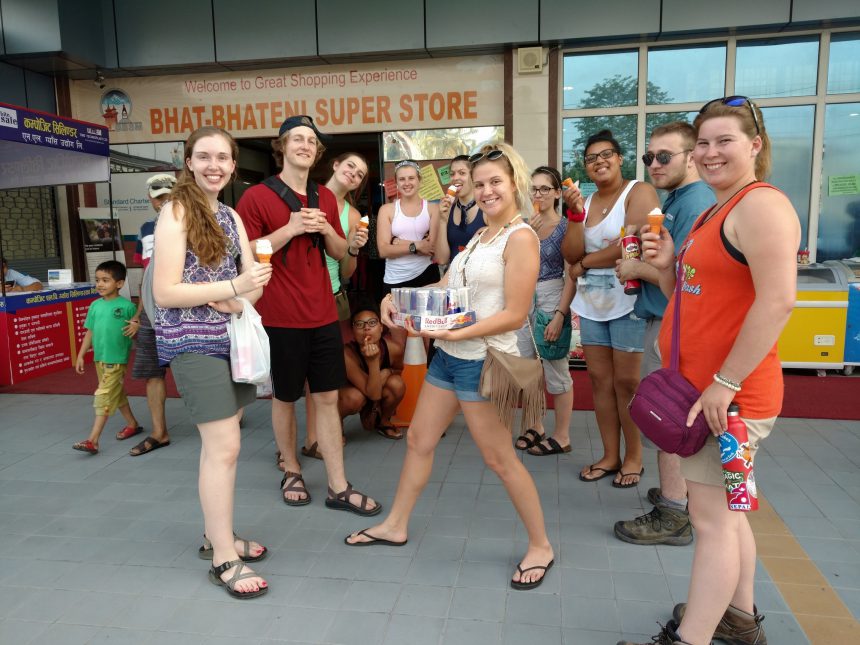
Day Thirteen
by Whitney Chandler
Today, our group was able to meet with the Nepal Veterinary Student Association. They welcomed us with flowers and a talk about the club, how it is structured, and the activities that they organize and participate in. They also talked about their beautiful country and what it has to offer.
Dr. Wilkins then gave a great talk about epidemiology to all of us. Dr. Subir Singh, a professor at AFU, ended the morning with a short presentation. He talked about the One Health phenomenon, where we do not focus on just humans or just animals, but look at both intertwined.
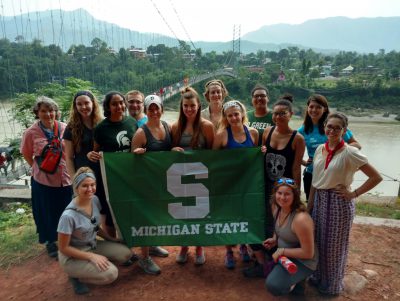
At first, I was under the impression that Dr. Singh was the club’s advisor. However, after talking to him, he explained that the students organize all of their own activities. One of their activities includes vaccinating and caring for the dogs on campus, which I thought was great! They also organize research projects that they publish in their own journal called Blue Cross. I am so impressed that they do all of this on their own.
After the meeting, we attended another lecture by Dr. Wilkins about influenza with a United States focus. It was very interesting to learn about the progression of the disease through the years. Dr. Wilkins explained that China is the source of most flus, specifically avian influenza, because of the close contact between birds, humans, and pigs. After lunch, we had another lecture on dairy processing and safety. Dairy products, other than milk, are relatively new in Nepal. They use buffalo, yak, and cow milk to make cheese, yogurt, and ice cream.
The rest of the day was full of nature and fun. We visited the only horse breeding farm in Nepal. They were beautiful—much bigger than I was expecting, and there were a ton of them. This breeding farm supplies horses for the military base in Kathmandu. The horses are bred on the farm and sent to Kathmandu for training and working after the age of three. In the last few years, the farm ran into problems with inbreeding, so they have imported new stallions from India.
The end of our day was the best. Dr. Singh arranged for us all to go to dinner with his family. We had a great meal and we were able to get henna tattoos. The henna artists are so good and it’s so interesting to see the unique design they create for each person. I keep falling in love with this country, and I can’t wait to see what the rest of our journey will entail.
Day Fourteen
by Becca Tanner
We were up bright and early this morning. The stifling, still air in our rooms when the ceiling fan stops working randomly during the night doesn’t stir me at all anymore.
We had our usual breakfast of an egg with chickpeas and a tortilla (add a Nescafé instant coffee to my order, please!), and got into our trusty van to head toward Chitwan National Park—more specifically, the town of Sauraha.
First on our agenda was a ride on an ox cart. If it sounds like an ancient practice, that’s because it is. We all loaded up onto three separate wooden wagons, each led by two strong oxen, and away we went. The streets of Sauraha weren’t nearly as populated with people and motorcycles as the streets in Kathmandu, which was a welcome change. Instead, we shared the road with different and much larger pedestrians. Huge Asian elephants loomed past us, always with one man perched on their backs, just behind their ears. Ponies pulling decorative carts also whizzed by. They were much faster than our slow and steady oxen.
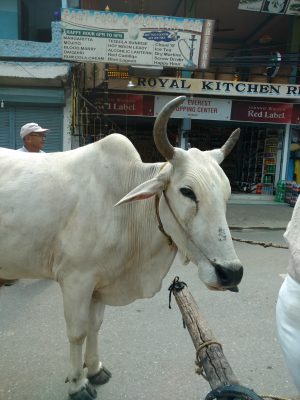
Eventually, we made our way to a cultural village, passing rice paddies and fields full of corn on the way there. We hopped down from our carts and visited a museum that educated us all about the Tharu people, who are indigenous to the Terai region of Nepal. After the museum, we wandered around the village. The homes there were all made of different materials, sometimes with elephant grass, which is similar to bamboo, and sometimes with a cement-like material. They were sturdy, meant to withstand everything from extreme heat to monsoons. We also passed by a military base where a baby rhino was grazing safely behind their stonewall, protected from tiger attacks. (That’s a big concern for an orphaned baby rhino around here!) We also stopped to see a huge river in the national park, where we spotted several crocodiles sinking ominously into the murky water.
Our wandering was decidedly ended by our guide’s “bad feeling” about the darkening sky, which proved to be very correct. We arrived back at the hotel just in time to seek shelter from the rain.
We were all very enthused at the idea of ordering something off of a menu, as we’d had an obligate diet of whatever they cook for us in the cafeteria at AFU. I stuck with a vegetable rice curry, but our table had a range of everything from mac and cheese to a club sandwich.
With full stomachs, we donned our ponchos and umbrellas and headed out into the rain to explore the shops that line the streets of the town. We flaunted our newly acquired bartering skills for the shop owners, ate ice cream, and marveled at the elephants parading down the road.
By late afternoon, we were ready to head back to AFU and relax in the dorms for the rest of the day.
A final note on how well-adjusted we are getting to life in Nepal: any given ride in the van is, to put it mildly, bouncy. More than half of us fell asleep on the way back.
Namaste for now!
